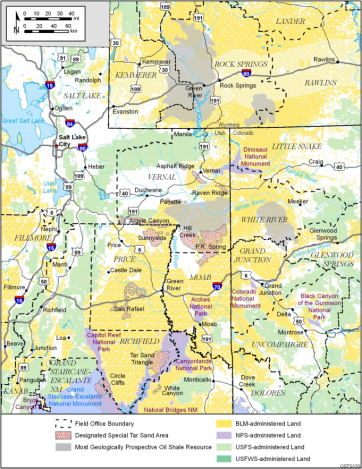Oil shale is a weird energy source. It’s a rock that contains shale oil, a type of hydrocarbon that differs from regular petroleum in part because it needs to be heated in order to be released. And it differs from the sort of shale in the Bakken Formation that’s feeding North Dakota’s oil boom — it’s much harder to extract. So hard to extract, in fact, that oil companies don’t even really try any more.
But that doesn’t mean they’re not irritated that the government intends to lock away federal land that sits over oil shale. After all, oil companies are ridiculously thin-skinned and greedy and use any opportunity to score political points. From The Hill:
The Interior Department on Friday issued a final plan to close 1.6 million acres of federal land in the West originally slated for oil shale development. …
Interior’s Bureau of Land Management cited environmental concerns for the proposed changes. Among other things, it excised lands with “wilderness characteristics” and areas that conflicted with sage grouse habitats.
Under the plan, 677,000 acres in Colorado, Utah and Wyoming would be open for oil shale exploration. Another 130,000 acres in Utah would be set aside for tar sands production. …
“This is another step in the wrong direction that limits development and investment in one of the nation’s most energy-rich areas and goes against a prior government decision that would allow for research and development over a much wider geographical area,” [said some jerk from the American Petroleum Institute.]
That “prior government decision”? It was “laid out in the final days of the George W. Bush administration.”
Ha ha. Oh, well if that guy thinks it’s a good idea …
Just yesterday, we noted a lawsuit hoping to prevent a Colorado water district from reserving a large amount of White River water for possible future oil-shale drilling. Prior to the decision, a coalition of groups wrote a letter to the acting director of the Bureau of Land Management expressing concern about the use of and risk to the region’s water from possible oil-shale exploration. As the West grows more and more dry, even small redirections of water become a big issue.
The next step in Interior’s decision-making process for the oil-shale lands is a 30-day comment period. And so, despite the fact that the government is still giving oil companies hundreds of thousands of acres to play with, expect some protest. Oil companies like to protest, because they are spoiled brats, the end.

ANL.govAn Interior map of the region at issue. Click to embiggen.
This post is part of our November 2012 theme: Post-election hangover — whither the climate?




